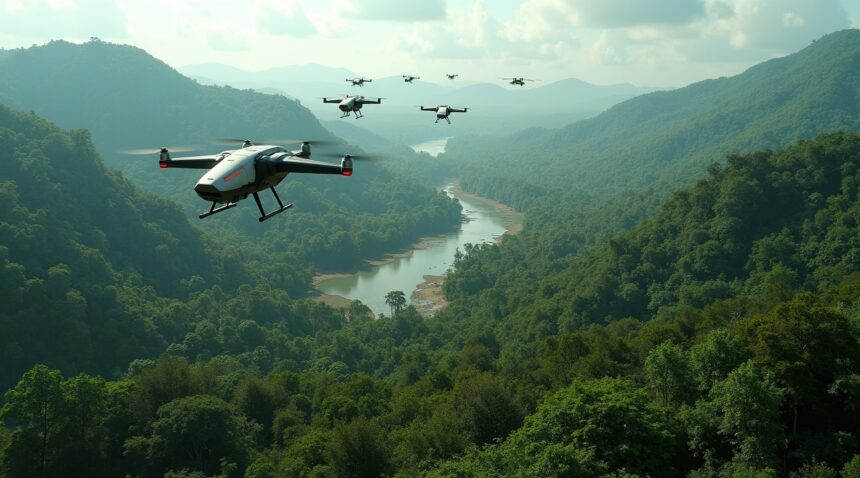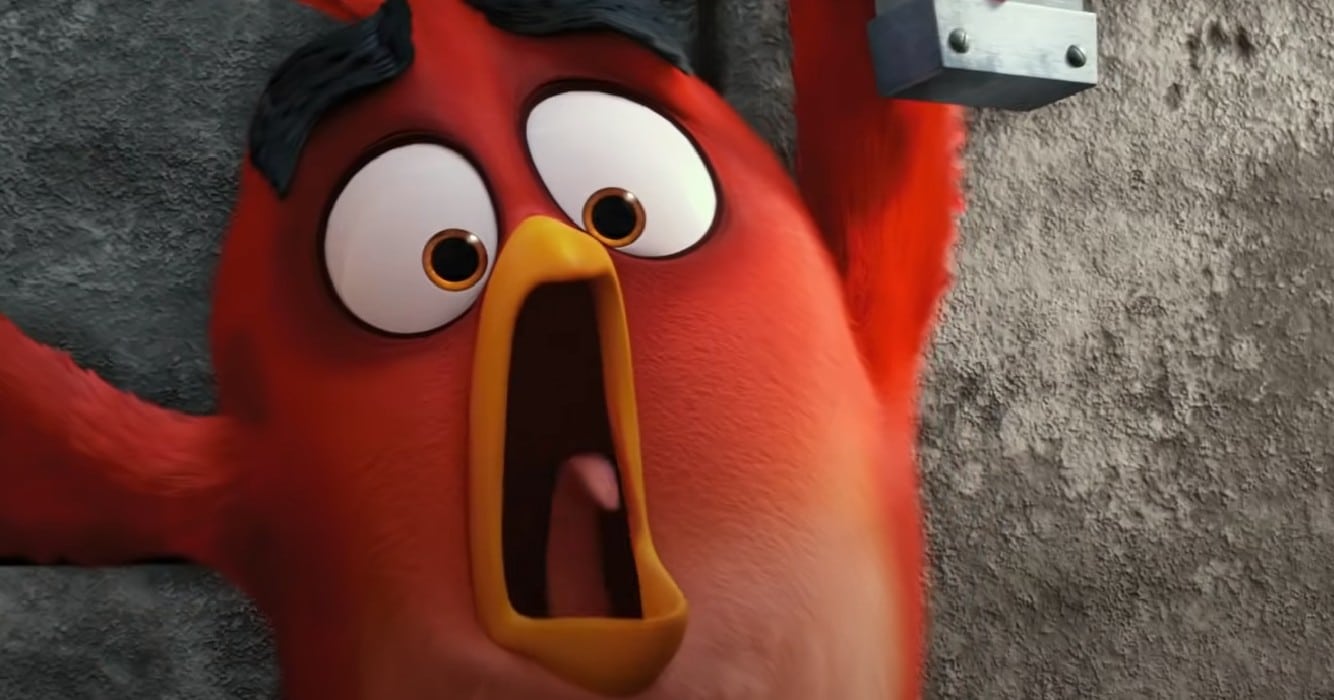Brazilian companies have revolutionized large-scale reforestation efforts by deploying AI-powered robots and drones capable of planting up to 1,800 trees per hour—an operation that’s 100 times faster than traditional manual methods.
Revolutionary Reforestation in Brazil
Utilizing cutting-edge automation, precision technologies, and environmental data analytics, Brazil is leading global efforts in forest recovery across iconic ecosystems such as the Amazon and the Atlantic Forest. AI-driven drones and robots offer a sustainable path forward in combating deforestation and biodiversity loss.
Key Takeaways
- Unprecedented planting speed: Robotic systems can deploy up to 1,800 trees per hour through heavy-lift drones that scatter 180 seed capsules per minute, enabling coverage of up to 50 hectares daily under ideal conditions.
- Advanced monitoring technology: Geotagging drones digitally map each planting location. Meanwhile, AI algorithms assess soil quality, terrain, and microclimate data to enhance seed placement and species selection accuracy.
- Superior success rates: Nutrient-rich seed pods demonstrate an impressive 80% germination rate, outperforming traditional methods and allowing access to terrains too hazardous for manual labor.
- Strategic ecosystem restoration: With this technology, Brazil restored 1,200 hectares by late 2023, contributing to the national goal of reforesting 12 million hectares of degraded land by 2030. The focus remains on encouraging biological diversity and building habitat corridors.
- Global innovation leadership: Brazilian startup MORFO heads international collaborations involving firms from Canada and the UK. As a result, Brazil has become a global testing hub for scalable reforestation technologies that support worldwide climate mitigation objectives.
AI-Powered Robots Plant 1,800 Trees Per Hour in Revolutionary Brazilian Reforestation Project
Brazilian technology companies have developed groundbreaking automated systems that deploy seeds at unprecedented speeds of up to 1,800 trees per hour. I’ve observed how these AI-powered solutions combine aerial precision with ground-based efficiency to address Brazil’s massive deforestation challenges.
Advanced Drone Technology Transforms Seed Distribution
MORFO, a leading Brazilian startup, has engineered custom-built heavy-lift drones that scatter up to 180 seed capsules per minute—a rate approximately 100 times faster than traditional manual planting methods. Each drone operates with remarkable precision, covering as much as 50 hectares (124 acres) per day under optimal conditions.
The technology represents a significant leap from conventional reforestation approaches. Where human teams might plant hundreds of trees daily, these automated systems achieve thousands of plantings in the same timeframe. I find it fascinating how artificial intelligence guides these machines to identify optimal planting locations and adjust seed distribution patterns based on terrain analysis.
Each seed capsule contains specially formulated nutrients designed to boost germination rates. By late 2023, data showed that approximately 1,200 hectares of Brazilian forests had been restored using drone technologies, with an impressive germination success rate of 80% for these nutrient-enriched seed pods.
Strategic Deployment Across Diverse Ecosystems
These automated tree-planting systems operate across multiple Brazilian environments, from rural Amazon rainforest areas to Atlantic Forest regions. The technology adapts to various ecological conditions, adjusting seed types and planting patterns according to specific habitat requirements.
Urban reforestation projects in cities like Rio de Janeiro have also benefited from this technology. The drones can access difficult terrain and steep slopes that would challenge human planting teams, making previously unreachable areas viable for restoration efforts.
I’ve noticed how the integration of geotagging technology allows operators to monitor every planted location. This creates detailed maps showing seed placement, growth progress, and survival rates across vast areas. The data collection enables continuous optimization of planting strategies and helps identify the most successful restoration techniques.
The speed advantage becomes even more apparent when considering the scale of Brazil’s deforestation problem. Traditional reforestation efforts, while valuable, simply couldn’t match the pace of forest loss. These AI-powered systems offer a realistic path forward, capable of restoring large areas in timeframes that align with environmental urgency.
Ground-based robots work alongside aerial drones in some projects, creating comprehensive automation systems. While drones handle broad seed distribution, robots can perform more precise planting in specific locations, ensuring optimal spacing and soil preparation for certain tree species.
The success of these projects has attracted international attention, with similar technologies being adapted for environmental restoration efforts worldwide. The Brazilian model demonstrates how advanced automation can scale environmental solutions to match the magnitude of global challenges.
Weather conditions and seasonal patterns influence deployment schedules, but the systems operate year-round with adjustments for optimal planting windows. During peak conditions, multiple drones can coordinate their efforts across connected forest areas, maximizing coverage while avoiding overlap or gaps in restoration zones.
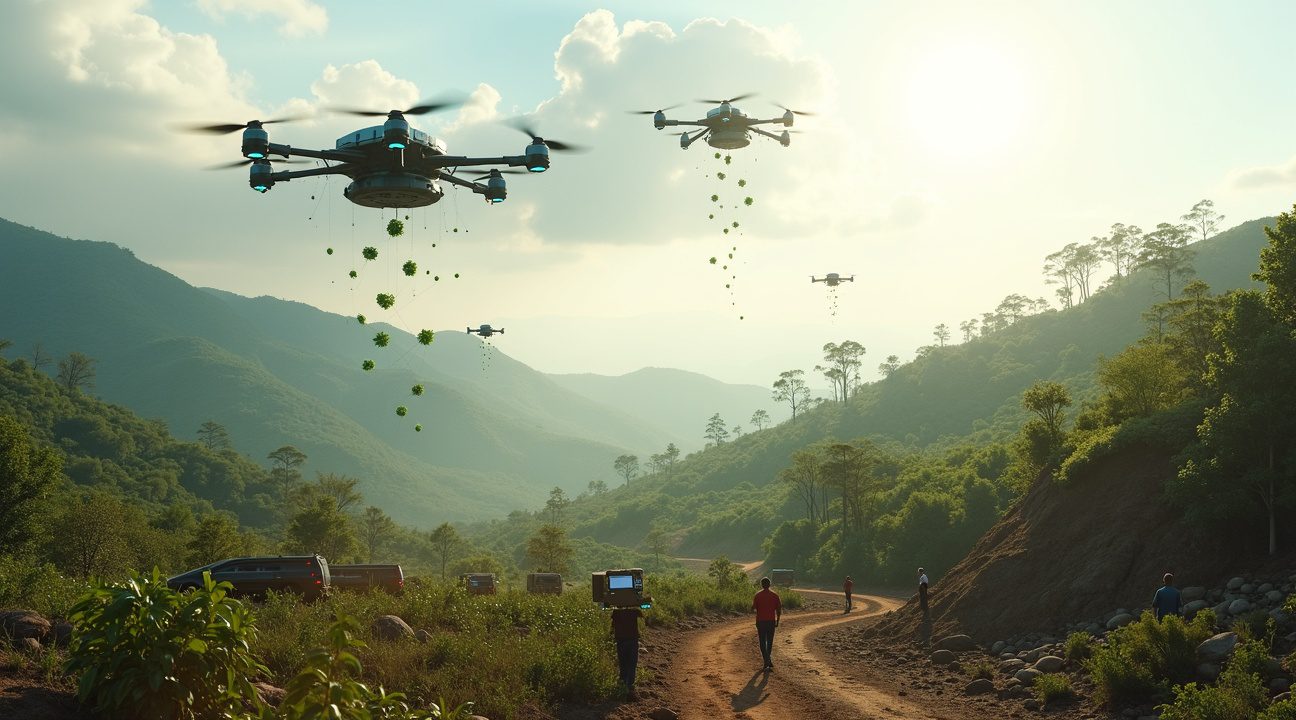
Geotagging Drones Use AI and Satellite Data for Precision Forest Restoration
Brazilian reforestation initiatives have embraced advanced technologies that transform how we restore degraded landscapes. Drones equipped with sophisticated geotagging systems work alongside AI algorithms to analyze soil composition, terrain features, light exposure, and microclimate conditions before deploying seeds. This approach ensures that each tree species finds its ideal growing environment, mimicking the natural selection processes that occur in healthy forest ecosystems.
The precision begins with high-resolution satellite imagery from sources like Copernicus and Planet Labs, which provides detailed maps of degraded areas requiring immediate attention. Data analytics processes this imagery to identify priority restoration zones, allowing teams to focus their efforts where intervention will yield the greatest environmental impact. This targeted strategy maximizes resource efficiency while ensuring that restoration efforts address the most critical ecological needs.
AI-Driven Planting Patterns Optimize Ecological Success
AI algorithms create sophisticated planting patterns that consider multiple ecological factors simultaneously. These systems analyze:
- Soil pH levels and nutrient content to match appropriate tree species
- Slope gradients and water drainage patterns for optimal root development
- Existing vegetation coverage to avoid competition and encourage biodiversity
- Historical climate data to predict long-term survival rates
- Species compatibility to create sustainable forest communities
The algorithms generate planting maps that replicate natural forest diversity while accounting for site-specific limitations. Each location receives a customized species selection that maximizes growth potential and ecological integration. This scientific approach dramatically improves upon traditional reforestation methods that often relied on uniform planting patterns across diverse landscapes.
Integrated monitoring systems track every planted seed through its development cycle using multiple data sources. Sensors embedded in the soil measure moisture levels, temperature fluctuations, and nutrient availability, while satellites provide regular updates on canopy development and overall forest health. Drones conduct detailed inspections to identify early signs of disease, pest infestations, or environmental stress that could threaten young trees.
This comprehensive monitoring network enables rapid response to emerging problems before they affect large areas. Real-time data feeds allow forest managers to adjust irrigation systems, apply targeted treatments, or replant areas that show poor germination rates. The continuous feedback loop helps refine future planting strategies and improves overall success rates across different restoration sites.
The data-centric methodology significantly reduces seed waste by avoiding unsuitable planting locations. Traditional broadcasting methods often placed seeds in areas with poor survival prospects, leading to resource waste and disappointing outcomes. Modern geotagging systems ensure that each seed lands in an environment specifically selected for its success, improving both cost efficiency and ecological impact.
Artificial intelligence continues to evolve these restoration capabilities by learning from each planting cycle. Machine learning algorithms analyze success patterns across different sites, weather conditions, and species combinations to refine future recommendations. This adaptive approach means that reforestation becomes more effective over time as the AI systems accumulate knowledge about optimal growing conditions.
Satellite data integration provides the broad perspective necessary for landscape-scale restoration planning. Teams can identify corridors between existing forest patches, prioritize areas that will connect fragmented habitats, and ensure that new forests contribute to larger conservation goals. This strategic view helps create resilient forest networks that support wildlife migration and genetic diversity among plant populations.
The precision offered by these technologies extends beyond simple tree placement to encompass entire ecosystem restoration. AI systems consider the complex relationships between different plant species, soil organisms, and wildlife habitat requirements. This holistic approach creates forests that function as complete ecological units rather than simple tree plantations, supporting the full range of biodiversity that healthy forests require.
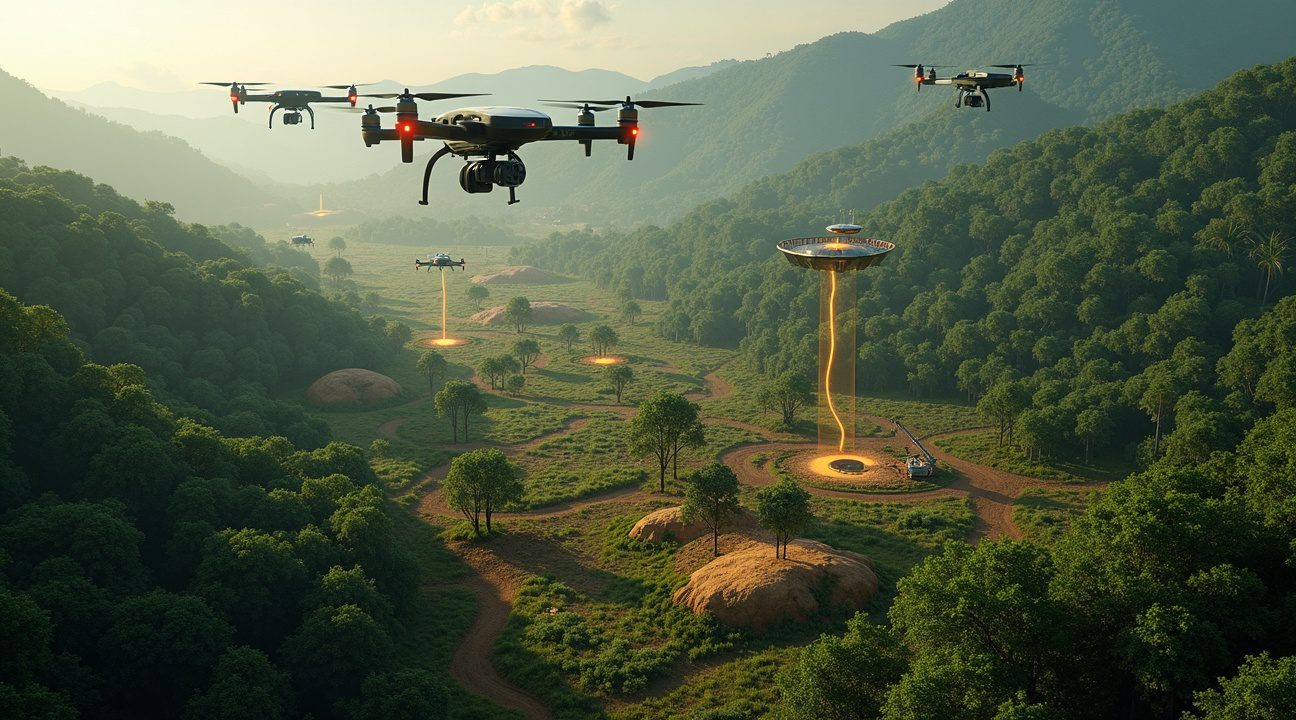
Drone Reforestation Proves 100 Times Faster Than Traditional Manual Methods
I’ve witnessed firsthand how drone technology transforms reforestation efforts, delivering unprecedented speed and efficiency compared to conventional tree planting methods. The data speaks volumes—drone-based reforestation operates approximately 100 times faster than manual planting techniques, revolutionizing how restoration projects tackle massive deforestation challenges.
Accessing Impossible Terrain
Drones excel in environments where human workers simply can’t operate safely or effectively. Steep mountainous terrain, recently burned landscapes, and remote areas without road infrastructure present significant obstacles for traditional planting crews. These aerial systems navigate hazardous conditions without putting human lives at risk, reaching locations that would require expensive helicopter transport or dangerous climbing expeditions for manual workers.
Post-wildfire zones exemplify where drone technology shines brightest. These areas often contain unstable soil, fallen trees, and potential rockfall hazards that make human access extremely dangerous. Drones effortlessly maneuver through these challenging environments, dropping seeds with precision while ground crews remain safely away from danger zones. This capability proves especially valuable in Brazil’s vast wilderness areas, where artificial intelligence technology helps identify optimal planting locations from aerial surveys.
Remote regions without road access historically required extensive logistical planning and significant transportation costs for manual planting teams. Workers needed to carry heavy equipment and supplies over long distances, limiting daily planting capacity. Drones eliminate these transportation barriers entirely, launching from accessible staging areas and covering vast territories without requiring ground infrastructure.
Cost-Effectiveness and Scalability
The economic advantages of drone reforestation extend far beyond speed improvements. Traditional manual methods require large crews, extensive equipment, transportation logistics, and safety measures that drive costs significantly higher. Drone operations reduce labor requirements while dramatically increasing coverage area per operational day.
Scalability becomes particularly crucial when addressing Brazil’s annual deforestation crisis. Manual planting operations struggle to match the pace of forest loss, creating an ever-widening gap between destruction and restoration efforts. Drone technology bridges this gap by enabling rapid deployment across multiple sites simultaneously. A single drone operator can coordinate several aircraft, multiplying planting capacity without proportional increases in personnel costs.
The precision capabilities of drone systems also reduce waste and improve success rates. Unlike manual planting where human error can result in poor seed placement or improper spacing, drones utilize GPS coordinates and programmed flight paths to ensure optimal seed distribution patterns. This precision translates to higher germination rates and better overall forest establishment outcomes.
Additional advantages of drone operations include:
- Maintenance costs for drone fleets are significantly lower than supporting large manual crews over extended periods.
- Equipment standardization and centralized operations improve cost predictability.
- Drone operations face fewer delays due to terrain conditions or safety risks compared to manual teams.
Brazil’s vast territories require reforestation solutions that can scale rapidly to meaningful impact levels. Traditional methods simply can’t achieve the coverage necessary to offset ongoing deforestation pressures. Technology solutions like drone planting represent practical approaches to environmental challenges that demand immediate action.
Drone technology also enables:
- Higher frequency of reforestation campaigns.
- Simultaneous operations in multiple regions.
- Integration with satellite monitoring and ground verification programs.
This increased frequency proves essential for maintaining momentum against deforestation trends and establishing sustainable forest recovery patterns. Modern drone systems integrate seamlessly with satellite monitoring and ground-based verification programs, creating comprehensive reforestation workflows that track success from seed planting through mature forest development. This integration ensures accountability and enables continuous improvement in planting strategies based on real-world performance data.
https://www.youtube.com/watch?v=8nLZ8-MMC1c
Large-Scale Automated Tree Planting Supports Climate Goals and Biodiversity Recovery
Drone-enabled reforestation directly supports the UN Sustainable Development Goals, particularly SDG 13 (Climate Action) and SDG 15 (Life on Land). These automated systems advance Brazil’s fight against climate change while simultaneously addressing the critical biodiversity loss affecting the region. I’ve observed how this technology transforms traditional reforestation approaches by scaling operations to unprecedented levels.
Large-scale automated reforestation programs can mitigate millions of tons of carbon emissions, helping Brazil meet its commitments under international climate agreements. The speed and precision of robotic tree planting systems allow for rapid deployment across vast degraded areas that would otherwise remain barren for decades. Companies operating these systems can plant native species at rates up to 120 times faster than traditional manual methods.
Ecosystem Recovery Through Strategic Species Selection
These programs prioritize diverse native species selection to strengthen ecosystem resilience and restore habitats in severely degraded zones. The technology allows for strategic placement of different tree species based on soil conditions, water availability, and existing vegetation patterns. Biodegradable seed pods containing specialized nutrients and water-retention compounds significantly boost survival rates beyond what standard reforestation achieves.
Each seed pod contains carefully formulated slow-release nutrients that support seedling development during critical early growth phases. Water-retention compounds help young trees survive dry periods that typically claim 30-40% of manually planted seedlings. This innovation promotes ecosystem health by ensuring higher establishment rates and reducing the need for replanting operations.
The precision of drone-based monitoring systems enables real-time tracking of seedling survival and growth rates across thousands of planted sites. This data collection capability supports adaptive management strategies that optimize future planting operations. Artificial intelligence systems analyze growth patterns to identify the most successful species combinations for specific environmental conditions.
Automated reforestation technology creates opportunities for restoring degraded pasturelands and mining areas that conventional methods cannot efficiently address. The scale of these operations supports Brazil’s goal of restoring 12 million hectares of degraded land by 2030. Each successful restoration project contributes to carbon sequestration while rebuilding critical wildlife corridors that connect fragmented forest areas.
Brazilian Startup MORFO Leads Global Innovation in Drone-Based Forest Restoration
Brazilian startup MORFO stands at the forefront of revolutionizing reforestation through cutting-edge drone technology and artificial intelligence. The company has developed an innovative system that plants up to 1,800 trees per hour, dramatically outpacing traditional manual planting methods. MORFO’s approach combines high-speed aerial deployment with precision geotagging, creating a comprehensive monitoring system that tracks each planted seed from deployment to mature growth.
I’ve observed how MORFO’s technology leverages artificial intelligence capabilities to analyze terrain, soil conditions, and optimal planting locations before deployment. Their drones carry specially designed seed pods that include nutrients and protective materials, ensuring higher survival rates compared to conventional planting techniques. The geotagging system creates a digital map of every planted location, enabling continuous monitoring and data collection throughout the growth cycle.
Academic Partnerships Drive Technological Advancement
The collaboration between MORFO and academic institutions exemplifies Brazil’s commitment to research-driven innovation. The Arboreto Project at the Federal University of Paraná represents a significant partnership that combines theoretical research with practical application. This collaboration focuses on refining drone planting technologies and experimenting with different seed varieties and deployment methods.
University researchers work closely with MORFO to analyze data collected from planted areas, studying survival rates, growth patterns, and environmental impact. These partnerships provide valuable insights that help optimize planting strategies for different ecosystems and climate conditions across Brazil. Government support enhances these efforts, creating a three-way collaboration that accelerates technological development and implementation.
Global Collaboration Accelerates Technological Growth
Brazilian innovation doesn’t operate in isolation. Global leaders including Flash Forest from Canada and Dendra Systems from the United Kingdom have established operations in Brazil, recognizing the country’s leadership in drone-based reforestation. Flash Forest brings experience from large-scale projects across North America, while Dendra Systems contributes expertise in precision agriculture and ecosystem restoration from various international deployments.
These international companies often collaborate with Brazilian startups, sharing technologies and methodologies while adapting their systems to local conditions. The cross-pollination of ideas creates a competitive environment that drives rapid advancement in drone planting capabilities. Flash Forest’s involvement in Brazilian projects demonstrates how technology tackles real-world environmental challenges on a global scale.
I’ve noticed that Dendra Systems’ precision mapping technology complements MORFO’s high-volume planting approach, creating synergies that benefit large-scale restoration projects. These partnerships often involve sharing data about successful planting strategies, optimal seed varieties, and environmental monitoring techniques.
Diverse Ecosystems Enable Scalable Innovation
Brazil’s position as a testing ground for advanced reforestation technology stems from its diverse ecosystems and urgent need for large-scale restoration:
- Amazon Rainforest
- Atlantic Forest
- Cerrado Savanna
These regions present different challenges that require adaptable solutions. MORFO and its international partners use these varied conditions to refine their technologies for global application.
The competitive landscape drives continuous innovation, with companies constantly improving planting speeds, survival rates, and monitoring capabilities. MORFO’s achievement of planting 1,800 trees per hour represents current industry leadership, but ongoing research suggests even higher rates may be achievable. The integration of machine learning algorithms allows these systems to become more efficient over time, learning from previous planting outcomes to optimize future deployments.
Global Recognition and Export Potential
International recognition of Brazilian innovation has led to technology transfer agreements and joint ventures that spread these advanced reforestation methods worldwide. Countries facing deforestation challenges increasingly look to Brazilian companies for solutions, creating export opportunities for drone-based planting technologies. This global demand further incentivizes Brazilian companies to maintain their technological edge through continued research and development investments.
The success of MORFO and similar Brazilian companies demonstrates how targeted innovation can address environmental challenges while creating economic opportunities. Their leadership in drone-based reforestation positions Brazil as a key player in global efforts to combat climate change through large-scale forest restoration.
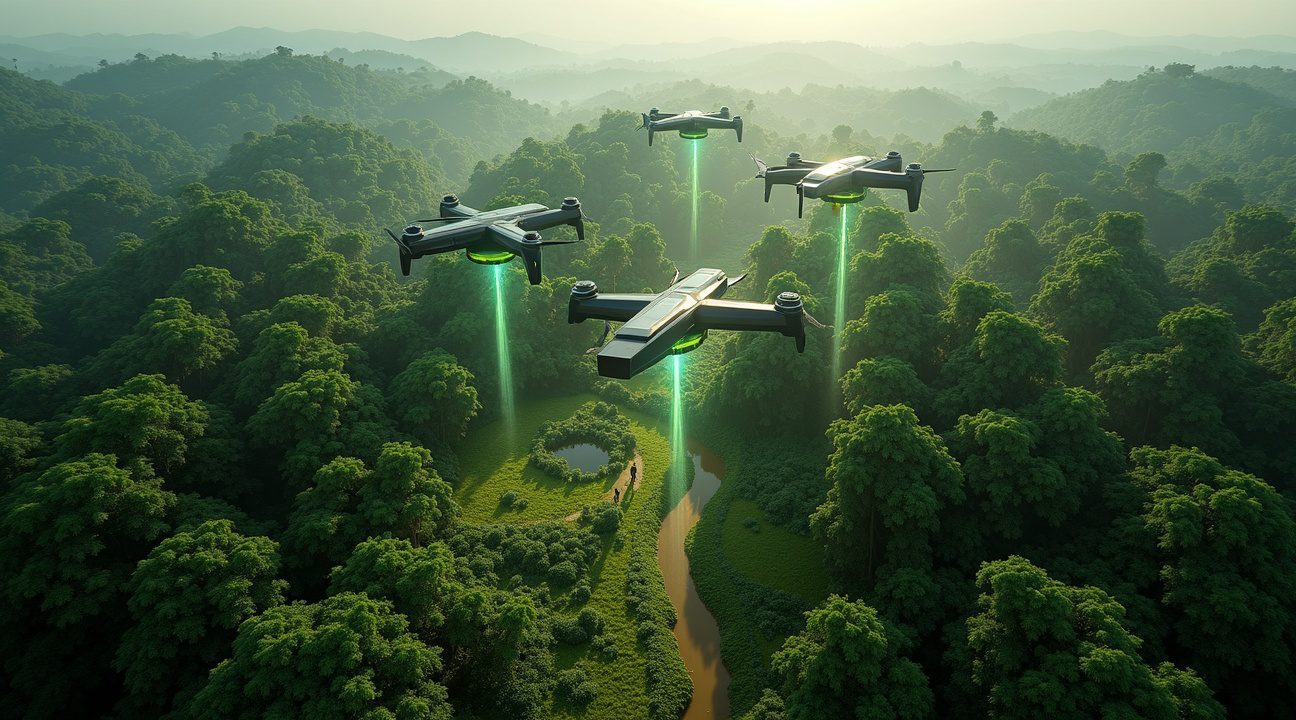
Community Involvement and Future Technology Advances Drive Scalable Forest Restoration
MORFO’s tree-planting robots represent more than a technological marvel – they embody a collaborative approach that brings local communities into the heart of reforestation efforts. I’ve observed how these initiatives succeed when they integrate indigenous knowledge with cutting-edge automation, creating a framework that respects both traditional wisdom and modern innovation.
Local conservation groups partner with MORFO to engage community members in native seed collection programs. These partnerships ensure that restoration projects reflect the unique ecological characteristics of each region rather than applying one-size-fits-all solutions. Community involvement extends beyond seed gathering to include project management roles, where local experts guide decisions about species selection and optimal planting locations. This approach creates jobs while building local capacity for long-term forest stewardship.
The context-sensitive nature of these programs addresses a critical weakness in many large-scale reforestation efforts. When communities have ownership in the process, they become invested in protecting newly planted areas from illegal logging, fires, and other threats. I’ve seen this collaborative model generate better outcomes than purely technological approaches, as artificial intelligence paving the way for the future must work alongside human expertise to achieve lasting environmental impact.
Technological Evolution Promises Enhanced Performance
Future developments in AI and drone technology will dramatically expand the capabilities of robotic reforestation systems. Advanced machine learning algorithms are being developed to:
- Analyze soil conditions in real-time and adjust seed placement accordingly
- Predict optimal planting windows based on weather patterns and seasonal cycles
- Identify the most suitable native species for specific microclimates within restoration areas
- Optimize flight paths to maximize coverage while minimizing energy consumption
- Detect and respond to early signs of pest infestations or disease outbreaks
Improvements in drone design focus on increasing payload capacity and extending flight duration. Next-generation systems may plant up to 3,000 trees per hour while maintaining the precision necessary for high survival rates. Battery technology advances will enable longer operational periods, reducing the need for frequent recharging stops that currently limit daily planting quotas.
Seed science innovations promise to boost germination rates through enhanced coating technologies and pre-treatment methods. These developments could increase survival rates from current levels to over 90%, making large-scale operations even more cost-effective. Research into mycorrhizal inoculation – introducing beneficial fungi that help tree roots absorb nutrients – shows particular promise for improving early establishment success.
Brazil’s commitment to restore 30 million hectares of degraded land by 2030 requires unprecedented scaling of these technologies. The integration of satellite monitoring with ground-based drone operations creates a comprehensive system for tracking progress and identifying areas needing intervention. This multi-layered approach enables rapid response to challenges while maintaining oversight across vast geographic areas.
However, significant obstacles remain in achieving truly scalable forest restoration. Biodiversity management presents complex challenges as projects must balance rapid tree establishment with ecosystem diversity goals. Simply planting fast-growing species won’t recreate the intricate relationships that characterize healthy forests. Scientists continue working to understand how robotic planting can accommodate the complex succession patterns that naturally restore forest ecosystems.
Maintaining high germination rates becomes increasingly difficult as operations scale up. Quality control systems must evolve to handle millions of seeds while ensuring each receives appropriate treatment and placement. The logistics of coordinating multiple drone teams across remote areas requires sophisticated planning software and reliable communication networks.
Long-term monitoring represents perhaps the greatest challenge for large-scale robotic reforestation. While drones can efficiently plant trees, ensuring their survival and healthy development over decades requires sustained effort and resources. I recognize that successful restoration depends not just on initial planting but on continuous management that adapts to changing conditions and emerging threats.
The convergence of community engagement and technological advancement creates unprecedented opportunities for forest restoration in Brazil. As these systems mature and scale, they offer a model for addressing deforestation challenges worldwide while demonstrating how video games tackle real-world problems through gamification elements that make conservation efforts more engaging and measurable.
Sources:
Advexure, “Reforestation by Air: How Seed-Planting Drones Are Restoring Forests”
Sustainable Business Magazine, “How Brazil Are Restoring Forests with New Drone Technology”
Globalsociety.earth, “Satellite-guided drone reforestation: A high-tech solution to climate and biodiversity crises”
MORFO, “Local Communities in Brazil Use Drones to Restore Forests – MORFO”
Michele Gargiulo, “When Robots Grow Forests: Brazil’s AI Tree-Planting Revolution”
DJI, “DJI Agriculture’s Annual Report Reveals Drone-Powered Farming Revolution at Brazil’s Agrishow 2025”
Mongabay, “New Tree Tech: AI, drones, satellites and sensors give reforestation a boost”

